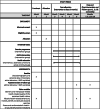The AHAWOMEN project: study protocol of a multi-design research for exploring HAPA predictors of exercise in postmenopausal women
- PMID: 37438855
- PMCID: PMC10337066
- DOI: 10.1186/s40359-023-01245-9
The AHAWOMEN project: study protocol of a multi-design research for exploring HAPA predictors of exercise in postmenopausal women
Abstract
Background: The postmenopausal period can represent an opportunity for women to improve their health and well-being. The Active and Healthy Ageing in Women during early postmenopause (AHAWOMEN) study aims to identify the key determinants of an active lifestyle among middle-aged women, with a focus on the stages and the social-cognitive variables outlined in the Health Action Process Approach (HAPA) model, a theoretical framework for understanding health behaviour change. We expected that HAPA factors and processes of intention creation (motivational phase) and action adoption (volitional phase) will be significant predictors of exercise initiation and maintenance, supporting both the HAPA tenets and the efficacy of HAPA-based interventions.
Methods/design: This study was approved by the authors' Institutional Review Committee. Postmenopausal women aged between 45 and 65 years will voluntarily participate. The participants will be allocated to one of three groups: Intervention-Initiators (n = 100, random allocation), Control-Sedentary (n = 100, random allocation) or Control-Active (n = 100, non-random allocation). The intervention group will engage in a supervised exercise programme lasting at least 3 months, supplemented with a HAPA-based intervention for behaviour change. The sedentary control group will not receive any intervention to change their physical activity, while the active control group will consist of women who are already regularly adhering to an active lifestyle. Study variables will be measured at baseline and postintervention phases, as well as at 1, 3, 6 and 12-month follow-ups. The predictors of exercise behaviour in the different phases of the behavioural change process will be explored and compared within and between groups throughout the study. These analyses will help identify the factors that determine the adoption of a healthy active behaviour. Additionally, the effectiveness of the model and the intervention for changing active behaviour will be evaluated.
Discussion: This paper describes the rationale, development and methods used in the AHAWOMEN project. Supporting women who intend to become active can help them to translate their goals into sustainable action. Verifying that the HAPA predictions are applicable to postmenopausal women's adoption of exercise would provide the basis for designing effective interventions for promoting healthy and active ageing that are also tailored to the experiences of middle-aged women.
Trial registration: ISRCTN16251361. Registration date: 01/06/2023 (retrospectively registered).
Keywords: Active lifestyle; Adherence; Health action process approach; Health promotion; Health-related behaviour change; Postmenopause.
© 2023. The Author(s).
Conflict of interest statement
The authors declare no competing interests.
Figures
References
-
- Foreman KJ, Marquez N, Dolgert A, Fukutaki K, Fullman N, McGaughey M, et al. Forecasting life expectancy, years of life lost, and all-cause and cause-specific mortality for 250 causes of death: reference and alternative scenarios for 2016–40 for 195 countries and territories. Lancet. 2018;392(10159):2052–2090. doi: 10.1016/S0140-6736(18)31694-5. - DOI - PMC - PubMed
-
- World Health Organization. GPAQ: Global Physical Activity Questionnaire (Version 2.0)..
MeSH terms
Grants and funding
- FEDER - Junta de Andalucía B-CTS-342-UGR20/Junta de Andalucía
- FEDER - Junta de Andalucía B-CTS-342-UGR20/Junta de Andalucía
- FEDER - Junta de Andalucía B-CTS-342-UGR20/Junta de Andalucía
- FEDER - Junta de Andalucía B-CTS-342-UGR20/Junta de Andalucía
- FEDER - Junta de Andalucía B-CTS-342-UGR20/Junta de Andalucía
LinkOut - more resources
Full Text Sources
Medical



